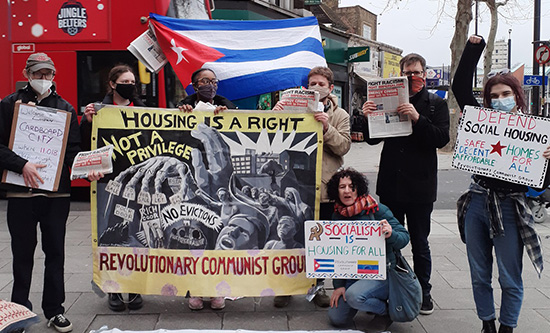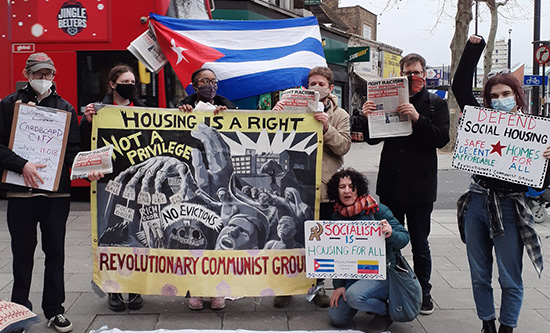
So profound is the crisis of British capitalism that the impact is increasingly being felt by previously more affluent sections of the working class, with young better-off workers denied the privileges they once aspired to. For decades, one of those has been the tantalising prospect of home ownership, a central plank of successive governments in buying the loyalty and acquiescence of vast swathes of the working class. That prospect is now in tatters. On 3 November the Bank of England increased its benchmark interest rate from 2.25% to 3%, its highest level for 14 years and the eighth consecutive increase since December 2021, when it was at a historic low of 0.25%. 1.2 million mortgage holders on flexible or tracker rates have felt the immediate effects of rates that are fluctuating around the 6% mark. By 2027, all mortgage holders will be affected. The Resolution Foundation has calculated that five million mortgaged households – nearly a fifth of all households – will be spending an average of £5,100pa more on housing costs by the end of 2024 – £8,000pa in London. For the two million mortgage holders on the lowest incomes, those costs are predicted to absorb 10% more of their income than in 2022. The Joseph Rowntree Foundation says an extra 120,000 households – or some 400,000 people – will face poverty when their current mortgage deal ends. This will swell the ranks of the 750,000 households with a mortgage (2.4 million people) already living in poverty.
The Bank of England says that by next year, around 800,000 households will be spending more than 70% of their take-home pay on mortgage repayments. The number of homes being repossessed rose by 15% in the third quarter of 2022. Nearly 75,000 homeowners are in arrears on their mortgage repayments. Small wonder that by October, demand for housing by first-time buyers was down 26%.
In a country where nearly two-thirds of the population (65%) own their own homes, and the ideological promotion of a ‘property owning democracy’ has held sway for more than four decades, this is hugely significant.
A ‘property owning democracy’?
Homeowners who have paid off their mortgages have seen property prices rise dramatically over the last 20 years and are now sitting on assets worth hundreds of thousands of pounds. They are clearly in a very different relation to capitalism than the poorest sections of the working class and as a consequence perceive their material interests very differently. In the 2019 election, for example, 57% of those who own their homes outright voted for the Conservatives (43% of mortgage holders); of the 365 seats won by the Tories in that election, 315 had homeownership levels above 64%. It’s no wonder the Labour Party (who received the votes of just 22% of homeowners of any sort) wants a piece of the action, positioning itself as the party of homeownership with a fatuous promise by Keir Starmer to raise property-owning levels to 70%.
Before the First World War, homeownership stood at around 10%. But in the interwar years, it became the norm for an emerging middle class, boosting ownership to about a third of the population. With the growth of building society mortgages and comparatively cheap property prices, highly paid sections of the working class began to aspire to a similar lifestyle and by 1971 around 50% of the population owned the homes they lived in. But it would not be until 1979, when Margaret Thatcher enshrined in law the Right to Buy council homes – with discounts of up to 44% – that the balance would be tipped in favour of a majority ‘property-owning democracy’. Even then, those who benefited were inevitably already better-off sections of the working class. A 1985-86 review noted that purchasers were ‘not a representation of tenants as a whole’, being disproportionately middle-aged, white, better-off white-collar workers and skilled manual workers on double the average council tenant salary. For the poorest tenants, of course, housing conditions became increasingly dire.The essential corollary to this huge sell-off of publicly owned housing was the 1988 Housing Act, which handed powers to landlords to set market rents and, through Assured Shorthold Tenancies, evict tenants essentially at will. It fuelled a massive rise in the phenomenon now dubbed ‘Buy to Let’, a nation of landlords funded by mortgages from banks newly freed from restrictions on lending. A majority of property owners was created almost in tandem with a massive expansion and deregulation of the private sector; the little that remained of publicly-owned housing was designated social housing, or ‘housing of last resort’ – increasingly available only to the most needy to whom local councils had a duty of care.
More state subsidies for first-time buyers
Following the financial crash of 2008/2009, lending requirements were made stricter. This, coupled with the astronomical rise of house prices, made it harder for young people to get on the property ladder. The Conservative government of 2015 felt it necessary to introduce a panoply of measures ostensibly to boost first-time home ownership – while at the same time giving handouts worth billions to the construction and development industry, a major Party donor. From 2012 onwards, these involved pouring public money into a raft of measures including equity loan schemes, ‘Help to Buy’, ‘Lifetime ISAs’ and Shared Ownership.
In reality these hugely expensive schemes benefited only a tiny percentage of well-off buyers. What they did do was pour money into the hands of private developers, help drive up house prices by around 68% between 2010 and 2022, and deplete the funds available for social rented homes. Most were designated as ‘affordable’ housing, allowing developers to sidestep their obligations to build housing at social rents without increasing the supply of housing overall. Data published by the Department for Levelling Up, Housing and Communities in November 2022 shows that 40 councils in England built no housing for social rent between 2016-17 and 2020-21. Over a third of councils (122) built 20 or fewer homes for social rent in this period.
The result has been that while around the millennium 60% of those aged 25-34 were buying their own homes, by 2015 the figure had dropped to 40%. In 2022, only 26% of people in the 25-44 age bracket now have a mortgage; for those under 35 the figure is 12%. In the first quarter of 2022, house price growth outpaced income by 21.7%. The median house price is now 8.4 times higher than median annual salary. In London home ownership has fallen below 50%, with average house prices 13 times the median full-time London salary of £38,000. Government figures show that between 2020 and 2021, the median annual salary for all homeowners was £39,768 (against a national median of £32,812); 50% of those buying with a mortgage earned over £50,000pa. Meanwhile, in the private rented sector, the median salary was £29,234 and in the social rented sector £16,175.
The nightmare of private renting
Already in 2018 the Resolution Foundation predicted that a third of ‘millennials’ – those born in the 1980s – would never own their own home and half would be renting in their 40s. This now looks an optimistic prediction. Private renting accounts for 19% of all housing tenures and around 4.4 million households. Rents are rising on average twice as fast as between 2018 and 2021. Low-income households are paying half their income on housing costs and in cities like London and Manchester around 40% is increasingly the norm across the board. Greater London is not just the region with the highest rents (at an average £1,846 per month) but also has the greatest shortages – with almost a third fewer homes available to rent than the pre-pandemic average and at least seven people chasing each vacancy. Nationally, the stock of homes for rent is half the average over the past five years. In these conditions, young people in particular are paying over the odds for rooms that are often cramped, squalid and even dangerous. Meanwhile, landlord repossession claims in England and Wales doubled from 10,202 in the 3rd quarter of 2021 to 21,012 in the same period this year, while so-called ‘no fault’ Section 21 evictions have risen 76% since the ban on evictions ended in May 2021.
There is a real need for all those now bearing the impact of this housing crisis to unite. That means a fight against a capitalist system in crisis no longer willing or able to extend decent housing provision to the majority of the working class – and for the provision of safe, decent, affordable publicly-funded homes for all.
Cat Wiener
FIGHT RACISM! FIGHT IMPERIALISM! 291 December 2022/January 2023




